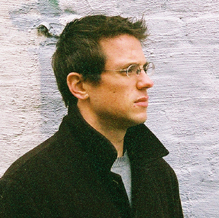 Thursday, March 24, 2005
Thursday, March 24, 2005
Burtner's "Making Noise"
An area of instrumental technique and history that interests me a great deal is extended techniques and Matt Burtner has a pretty good article on the topic over at New Music Box.
Extended techniques, as the name implies, requires the performer to play an instrument in a manner outside of what would be considered a traditionally established norm. These techniques include multiphonics, circular breathing, quarter-tones, slap-tonguing, key clicks, muting, playing with the mouthpiece alone, tapping on the instrument's body, all manners of bowing, and playing on the inside of the piano, to name just a few. Extended techniques as we know them today first appeared in concert music in the early twentieth century--Henry Cowell's Tides of Manaunaun (1915), Mosolov's Iron Foundry (1928), Varèse's Ionisation(1929-31)--but experienced a true renaissance in the 1960s.
Because of the growing world of electronic music, composers were now confronted with the task of finding a way to bridge the gap between the seemingly disparate electronic and acoustic sound worlds. Extended techniques provided that link. While the exploration of extended techniques in new music was widespread, many people point to the publication of the Italian theorist/composer Bruno Bartolozzi's New Sounds for Woodwind in the late 1960s as a codification of these efforts. For Burtner, composers' exploration of extended techniques in the twentieth century built a foundation and prepared instrumental performance to face new musical challenges in the twenty-first century.
Among the many good points that Mr. Burtner makes in his article is that extended techniques provide a way for the performer to personalize their instrument and draw out its unique qualities, and in the process develop a very personal approach and sonic vocabulary. He also observes, quite correctly, that these techniques more or less ran their course in concert music in the 1960s and 1970s, with the most advances and interesting work with them being done in the 1990s not by composers, but free improvisers and electronic musicians. And finally, he makes an extremely important claim: extended techniques are no longer an "other" in instrumental technique, but rather are an integral part of each instrument's identity today.
Although most of his article is stellar, I was a bit disappointed with his take on virtuosity. Burtner sees virtuosity as a barrier to the acceptance of extended techniques as a standard component of conservatory instrumental or vocal training. By virtuosity I'm assuming he means the traditional virtuosic model. However, in the late 1960s, in the wake of the explosion of new instrumental and vocal techniques, Eric Salzman coined the term "new virtuosity," which is certainly alive and well today. I see evidence of this in new music being written for all instruments. And if extended techniques really are no longer an "other," what's getting in the way of them being taught? Certainly not traditional virtuoisty. I think it's an issue of receptivity. The way I see it, some students are choosing a well-worn path and others are choosing to take the road less traveled.
Two errors in Mr. Burtner's article: Bartolozzi's New Sounds for Woodwind was originally published in 1967, not 1982; and Berio's Sequenza VIIb is for soprano saxophone, not alto, something that Burtner, a saxophonist, should be embarrassed to have gotten wrong.
posted by Brian Sacawa
11:05 PM
|
|
 Praised by The New York Times as "an inventive musician . . . fresh and surprising," saxophonist Brian Sacawa has firmly established himself as an important contemporary voice for his instrument. He is active as a soloist, recitalist, and chamber musician throughout the United States and is the co-founder of the new music duo Non-Zero with percussionist Timothy Feeney.
Praised by The New York Times as "an inventive musician . . . fresh and surprising," saxophonist Brian Sacawa has firmly established himself as an important contemporary voice for his instrument. He is active as a soloist, recitalist, and chamber musician throughout the United States and is the co-founder of the new music duo Non-Zero with percussionist Timothy Feeney.
He has given premieres of over thirty works by both established and emerging composers, including Michael Gordon, Bright Sheng, Andrew Mead, Oliver Schneller, Ken Ueno, Beata Moon, Hillary Zipper, and Scott McAllister, among many others. Named the Baltimore CITYPAPER’s Critic’s Choice for Classical Music in 2002, he is the recipient of awards for solo performance from both national and international competitions.
Sacawa's versatile career has led to appearances with the St. Petersburg Philharmonic, the Detroit Symphony Orchestra, the New World Symphony, Harvard Group for New Music, New Music Brandeis, Bargemusic, and at meetings of the ISU Contemporary Music Festival, World Saxophone Congress, North American Saxophone Alliance, and New England Saxophone Symposium.
Brian holds degrees from the University of Michigan, the Peabody Conservatory, and the University of Massachusetts – Amherst, where he studied with Donald Sinta, Gary Louie, and Lynn Klock. He has recorded for the Equililbrium, Naxos, and BiBimBop recording labels.
See Brian's other blog
Sounds Like Now
| |



